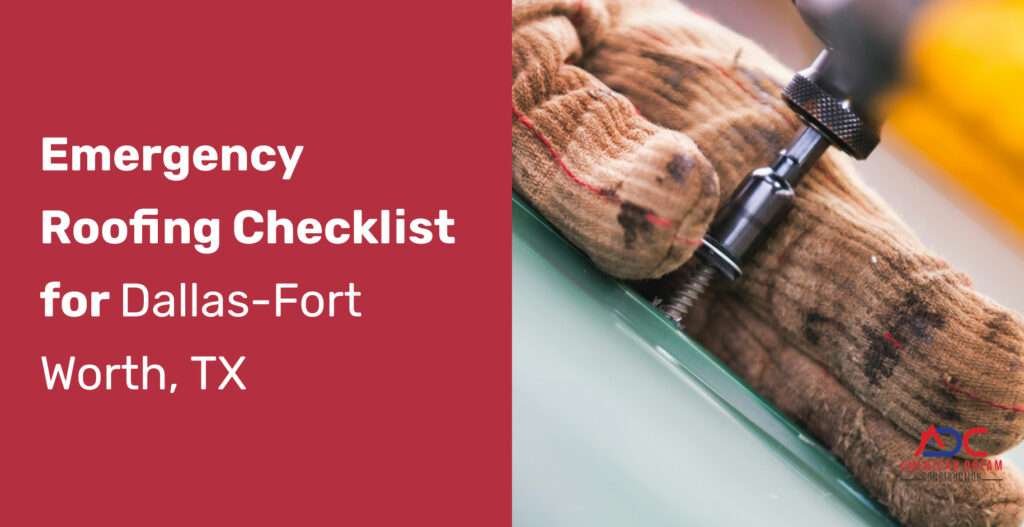Imagine this: It’s a regular sunny day in Dallas-Fort Worth, but out of nowhere, ominous clouds gather, and suddenly, a powerful storm descends upon your neighborhood.
With rain hammering against your windows and wind roaring through the streets, concerns about the stability of your roof creep in.
In times like these, having a detailed emergency roofing checklist designed specifically for the challenges of the Dallas-Fort Worth region can be a lifesaver.
We’ve created a checklist in this guide to make assessing your roof easier during an emergency.
Or, you can contact us at 844-893-7326 or book an appointment to handle your roofing situation.
Understanding Roofing Emergencies in Dallas-Fort Worth
In the lively Dallas-Fort Worth area of Texas, roofing emergencies are a common concern.
With the region’s unpredictable weather, including hailstorms, strong winds, and heavy rains, homeowners and property owners must be ready for anything Mother Nature sends.
According to Weather Stem, Texas faces an average of 30 to 60 severe thunderstorm days yearly, often resulting in significant roof damage.
Additionally, the state sees over 1,143 hailstorm events annually, as the Insurance Information Institute reported, earning it the top spot for states with the most hailstorm events.
As noted by Dallas News, recent hail storms in Texas caused an estimated $1 billion in damages.
The Dallas-Fort Worth area bears the brunt of many of these thunder and hail storms year after year.
Given these facts, a proactive emergency plan is essential for protecting your home and loved ones.
The Checklist for Emergency Roofing

Safety Precautions Before Inspection
Wear appropriate safety gear:
- Heavy-duty gloves safeguard your hands from sharp debris.
- Sturdy shoes provide traction on slippery surfaces.
- A hard hat shields your head from falling objects.
When inspecting your roof, stay alert for hazards above and below.
Look out for dislodged electrical wires that pose an electrocution risk, and be cautious around utility poles and transformers.
Watch for unstable surfaces like weakened tree limbs or debris-covered pathways, and take your time to assess stability before proceeding.
When in doubt, opt for caution and avoid potentially unsafe areas.
Assessing Roof Damage
Once safety measures are in place, start your inspection by thoroughly assessing your roof’s interior and exterior.
Carefully check your home’s ceilings and walls for any water stains or discoloration, which often signal a leak.
Look out for bubbling or peeling paint, indicating potential hidden moisture damage.
Remember to inspect your attic or top floor for signs of dampness or mold growth, as these can indicate ongoing roof leaks or ventilation issues.
Outside, scrutinize every inch of your roof’s surface for visible damage.
Pay close attention to the condition of your shingles, checking for any missing, cracked, or curled pieces that could compromise your roof’s integrity.
Check the flashing around chimneys, vents, skylights, and roof edges for signs of wear and tear, as these areas are prone to leaks during heavy rain or windstorms.
Additionally, examine your gutters and downspouts for blockages or damage, as clogged drainage systems can worsen water infiltration issues.
As you conduct your inspection, document any damage you find.
Take photographs or videos from various angles, capturing wide shots of your entire roof and close-ups of specific areas of concern.
Note the date, time, weather conditions during your inspection, and any recent storms that may have contributed to the damage.
This documentation will be crucial for insurance claims, helping to substantiate your case and ensure fair compensation for repairs.
Temporary Repairs and Damage Mitigation
Immediately after a roofing emergency, acting swiftly to minimize any additional damage is crucial.
Take immediate steps like covering exposed areas with tarps or securing loose shingles where it’s safe.
These temporary fixes can provide valuable time until professional assistance arrives.
Contacting Professionals
When it comes to emergency roofing repairs, time is critical.
Don’t tackle it alone—reach out to us for immediate assistance.
At American Dream Construction, we’re experts in emergency roofing services.
We’ve resolved countless situations like yours, restoring roofs to their best condition to safeguard residents and property value.
Call us at 844-893-7326 or schedule an appointment to address your roofing emergency.
Communicating with Insurance
Navigating the insurance claims process can feel overwhelming, but it doesn’t have to be.
The key? Clear communication and thorough documentation of damage.
As stated earlier, provide photos, videos, and repair estimates to bolster your claim, ensuring you get the coverage you deserve.
And if you prefer, we’re here to lend a hand throughout the entire insurance process, so you never have to go it alone.
Monitoring and Preventive Measures
After repairs, staying vigilant about your roof’s condition is important.
Monitor for any new signs of damage and schedule routine inspections and maintenance.
To safeguard against future issues, consider proactive steps like adding impact-resistant shingles or trimming overhanging branches.
These precautions can help prevent emergencies down the line.
Apart from that, we at American Dream Construction offer tailored roof maintenance plans for property owners.
We aim to keep your roof in top shape, ready to tackle the challenging weather conditions that DFW experiences year-round.
If you need maintenance plans, contact us at 844-893-7326, or similarly, you can book an appointment.
Conclusion
Our comprehensive emergency roofing checklist is customized for the Dallas-Fort Worth area.
It empowers homeowners and property owners to safeguard their investments and enjoy peace of mind.
So, when the storm clouds loom, will you be prepared to weather any challenge?
